One of the main reasons people come to Iceland is to experience the many natural wonders the country has to offer. Iceland truly is a place like nowhere else on Earth. The landscapes the country has to offer are incredibly varied and practically unmatched. The country’s volcanic origins are still present today and this geothermal activity provides visitors to the land of fire and ice with many unique attractions.
If you’re planning a trip to Iceland, the Geysir hot springs and the mighty Strokkur are must-see wonders; But what exactly are they and why are they must-see attractions. In this guide, you will have all the mysteries of Geysir and Strokkur unravelled. So grab your jacket and your camera because it’s time to get acquainted.
What is Geysir?
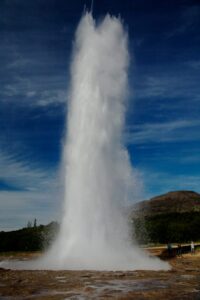
Geysir is probably the most famous geyser in Iceland. It is visited by tens of thousands of tourists every year. A geyser is a natural hydrothermal feature characterised by intermittent eruptions of hot water and steam ejected from the Earth’s surface. These eruptions are driven by the buildup of pressure beneath the ground due to geothermally heated water turning into steam.
To put it simply, a geyser is a hole in the ground where volcanically heated water begins to turn to vapour which causes a lot of pressure to be released resulting in what looks like an explosion of water.
The History of Geysir
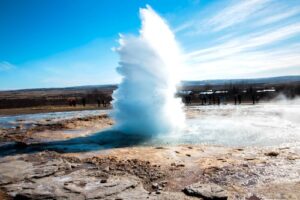
Nestled in the heart of Haukadalur valley, Geysir is a geothermal wonder that has been captivating visitors for centuries. Named after the Icelandic verb “gjósa,” meaning “to gush,” Geysir is renowned for its sporadic eruptions, shooting scalding water high into the sky. The history of Geysir dates back to the 13th century when it was first mentioned in Icelandic literature. This living, breathing natural marvel has since become a symbol of Iceland’s geological prowess.
Geysir’s journey through time is marked by tales of awe-inspiring eruptions that have been witnessed by generations. It has played a role not only as a geological attraction but also as a cultural and historical icon for the people of Iceland. The sagas are filled with stories of locals and explorers alike marvelling at the power and beauty of Geysir, making it an integral part of Iceland’s narrative. Geologists agree that Geysir has been active for at least 10,000 years. It hasn’t erupted since 2016, and the previous one was 16 years earlier, however it is still classified as active and could return to a regular eruption schedule in the future.
What is Strokkur?
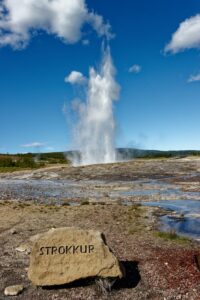
Strokkur, Geysir’s lively neighbour, steals the spotlight with its regular and reliable eruptions. The word “Strokkur” translates to “churn,” a fitting name for a geyser that churns and spouts water with impressive regularity. Although Iceland has a very long history, Stokkur was only discovered in 1789 after an earthquake reawakened its dormant state, Strokkur has been delighting onlookers ever since. While Geysir may be the older sibling, Strokkur’s consistent performances make it the shining star of Haukadalur.
A Brief History of Strokkur
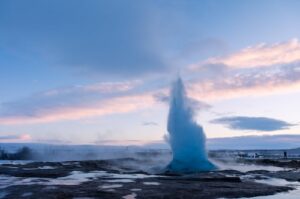
Strokkur’s history is one of resilience and reawakening. After its initial discovery, it became a prominent feature of the geothermal landscape. Its reliability and rhythmic eruptions make it a favourite among visitors. Strokkur, in a way, symbolises the resilience of nature and the constant rebirth that characterises Iceland’s dynamic geology.
Where is Geysir in Iceland?
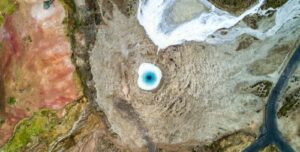
If you would like to visit Geysir, you will need to head towards the mystical landscapes of the Haukadalur Valley. Geysir proudly stands here, surrounded by geothermal activity that adds an otherworldly touch to the scenery. Located in the southwestern part of the, about 100 kms from the capital city, Reykjavík, Haukadalur is easily accessible and promises an adventure like no other.
Haukadalur valley, aside from being the home of Geysir, is a geological wonderland waiting to be explored. The landscape is dotted with fumaroles, hot springs, and mud pots, creating a surreal atmosphere. As you approach Geysir, the distinct smell of sulphur fills the air, a reminder of the powerful forces at play beneath the Earth’s surface.
What Other Geysers Are There in Iceland?
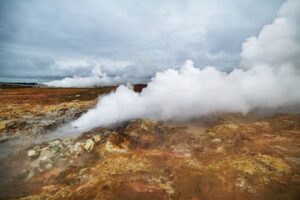
Iceland isn’t stingy when it comes to geysers. Apart from Geysir and Strokkur, the country boasts numerous other geothermal wonders. Some notable geysers include:
Litli Geysir
Translating to “Little Geysir,” this smaller geyser is located near Geysir. While it may not reach the heights of its larger counterparts, Litli Geysir adds to the overall geothermal spectacle in the area.
Hvítárgígur
Located in the Geysir Hot Springs area, Hvítárgígur is a smaller geyser that occasionally erupts, contributing to the geothermal activity in the region.
Konungshver
Situated in the Geysir Hot Springs area, Konungshver is another geothermal feature known for its occasional eruptions.
The variety of geysers in Iceland adds a layer of excitement to any traveller’s journey. Each geyser has its own personality, some being more boisterous while others display a quiet elegance. Exploring these geysers provides a glimpse into the diverse geothermal activity that defines Iceland’s landscape.
Which Geysers Erupt in Iceland?
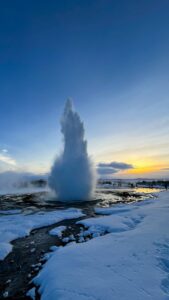
Iceland’s geysers have distinct personalities. Some erupt with majestic grandeur, while others prefer a more subtle approach. One of the most concentrated regions of regularly erupting geysers is in the Haukadalur Valley. In general, locals refer to this hot spot (pun intended) as the Geysir Area. There are currently between 20 and 29 active geysers in Iceland depending on the level of geothermal activity and there are almost 40 different locations with dormant or extinct geysers.
The Haukadalur Geysers are the most famous because they offer a captivating spectacle that showcases the raw power of nature. From the hissing steam to the explosive eruptions, each geyser contributes to the symphony of geothermal activity that defines the region. It’s a dynamic display that underscores the geological uniqueness of Iceland.
How Regularly Does Strokkur Erupt?
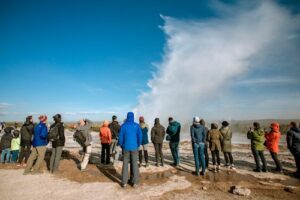
Strokkur is the most reliable performer in this geothermal theatre. Erupting roughly every 8-10 minutes, it’s like a Broadway star that never misses a cue. So, if you’ve missed one eruption, don’t worry; another mesmerising show is just around the corner.
Strokkur’s punctuality is a testament to the precision of nature’s clockwork. Whether you’re a morning person or a night owl, you can count on Strokkur to put on a show at regular intervals. Strokkur is more reliable than most countries’ postal services!
How High Does Strokkur Erupt?
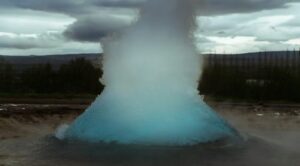
Strokkur’s eruptions can reach up to 30 metres (98 feet) in height. To put that in perspective it’s taller than about eight adult giraffes standing on top of each other.
Strokkur’s impressive height adds a theatrical element to its eruptions. It’s not just about the water shooting into the sky; it’s the grandeur and scale that make each eruption a moment of pure awe. There is also an impressive rumble and sizzling sound as it begins its eruption, followed by the splatter of boiling hot water landing on the surrounding stone.
How Much Does it Cost to Visit Geysir?

The good news for budget-conscious travellers is that nature’s wonders are often free of charge. Geysir and Strokkur welcome visitors without any admission fees, allowing you a bit of extra spending room to splurge on a cosy Icelandic sweater instead. For those who might take this suggestion seriously, it is actually possible to buy a genuine Icelandic wool sweater at the Geysir gift shop. There is also a very well-established clothing line named after this wonder.
Iceland’s commitment to accessibility means that you can experience the marvels of Geysir and Strokkur without breaking the bank. The absence of entrance fees invites all travellers to immerse themselves in the magic of these geothermal wonders. Icelanders are very proud of their nature and do whatever they can to ensure that these incredible marvels will continue to be around for many years to come so they can be enjoyed by all.
How to Get to Geysir

The Geysir Geothermal Area is very easy to access by car. It has a parking lot and it’s very clearly signposted. The main mode of transport to get to this area of the country is by car but there are two different ways travellers can go about this. You could rent a car and drive yourself, or you could join a guided tour.
Self-Drive

Iceland’s open roads are a traveller’s dream. Rent a car, hit the road, and enjoy the freedom of exploring Haukadalur valley at your own pace. Keep in mind, though, that Icelandic weather can be as unpredictable as a cat’s mood, so check road conditions and weather forecasts before embarking on your journey. The best place to get up-to-date information on road and weather conditions is the national road advisory.
Self-driving through Iceland allows you to create your own adventure. The journey to Geysir becomes an integral part of the experience as you navigate through ever-changing landscapes. Just remember to pack essentials, dress in layers and bring a sense of adventure and a willingness to embrace the unexpected.
Take a Guided Tour
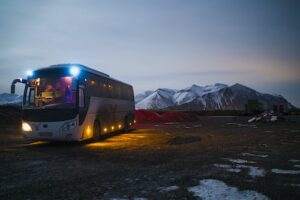
If you’d rather leave the driving to someone else, join a guided tour. Knowledgeable guides not only navigate the winding roads but also share fascinating tales about the geysers, adding a layer of storytelling to your adventure.
Guided tours offer more than just transportation; they provide a curated experience that enhances your understanding of Geysir and Strokkur. The stories and insights shared by guides add depth to your journey, turning it into an educational and entertaining exploration.
Iceland also has very strict regulations on who is allowed to call themself a guide, so in general, if you take a guided tour, you can be guaranteed to some degree that there is a minimum quality and safety level you can expect.
When is the Best Time to See the Geysers in Haukadalur Valley Erupt?
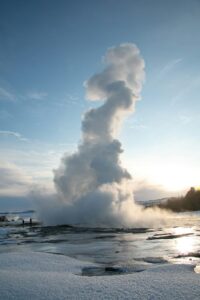
Iceland’s weather is like a box of chocolates – you never know what you’re going to get. However, the best time to witness the geysers in all their glory is during the warmer months, from late spring to early fall. Plan your visit between May and September for a higher chance of clear skies and more pleasant temperatures.
The choice of timing can significantly impact your experience at Geysir and Strokkur. Visiting during the warmer months not only increases the chances of favourable weather but also allows you to explore the surrounding landscapes without the chill of Icelandic winter.
What Times Can You Visit Geysir?
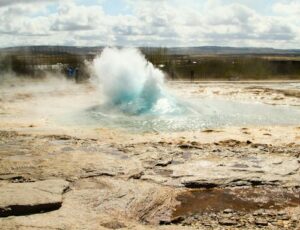
Nature doesn’t adhere to a strict timetable, but Strokkur is usually awake and ready to impress at any time of day. Early birds can catch the first rays of the sun illuminating the geysers, while night owls can experience the magic of the eruptions against a backdrop of the Northern Lights during winter.
Flexibility is the key when planning your visit. Whether it’s witnessing the morning sun reflecting off the erupting water or enjoying the ethereal beauty of the geysers under the northern lights, each moment offers a unique perspective. Keep in mind that Iceland’s ever-changing weather might add an unexpected twist to your experience.
How Do Geysers Form?
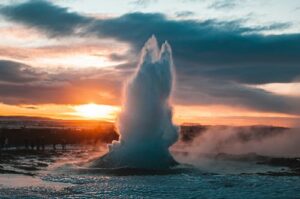
Geysers are like nature’s pressure cookers, created by a delicate balance of heat and water. The process begins with underground water being heated by magma, turning it into steam. As the pressure builds up, it forces the water to erupt, creating the awe-inspiring spectacle you can witness at Geysir and Strokkur.
Understanding the science behind geysers adds a layer of appreciation to your visit. The geological forces at play beneath the Earth’s surface contribute to the dynamic and captivating eruptions. It’s a reminder that what appears as a momentary spectacle is, in fact, the result of intricate natural processes that took millions of years to create.
How Much Time Should You Spend at Geysir?

While some may be content with a quick visit, true geyser enthusiasts might want to linger a bit longer. Plan for at least a couple of hours to explore the surrounding geothermal wonders, take in multiple Strokkur eruptions, and perhaps indulge in a picnic amidst Iceland’s surreal landscapes. There is also a restaurant onsite at the Geysir visitor centre, so it could be a great place to stop for lunch or a coffee.
Geysir and Strokkur are not just destinations; they are experiences. Allowing yourself ample time ensures that you don’t rush through the marvels of Haukadalur valley. Wander around, breathe in the geothermal air, and let the magic of the geysers cast its spell on you.
Directions to Geysir
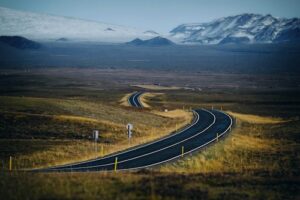
Finding your way to Geysir is part of the adventure but it’s not hard. If you’re driving, follow the signs and the GPS coordinates. If you’re on a guided tour, simply sit back, relax, and let the experts take care of the navigation. Either way, the journey to Geysir is as enchanting as the destination itself.
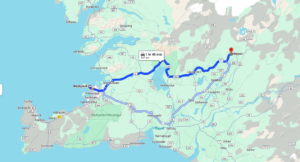
From Reykjavík, take Route 1 and then Route 35. It’s a pretty straightforward drive that is well-signposted, but don’t be surprised if the landscape challenges your sense of direction. There can sometimes be occasional detours due to weather conditions but this can often lead to hidden gems.
Conclusion
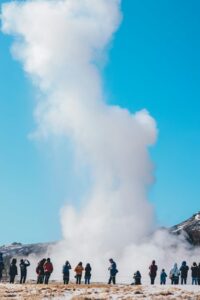
As you embark on your Icelandic escapade, make sure Geysir and Strokkur are at the top of your itinerary. From the rich history of Geysir to the rhythmic eruptions of Strokkur, Haukadalur valley promises a mesmerising experience that will etch itself into your travel memories. So, pack your sense of wonder, embrace the unpredictable Icelandic weather, and get ready to be spellbound by the natural wonders of Geysir and Strokkur. Safe and memorable travels!

